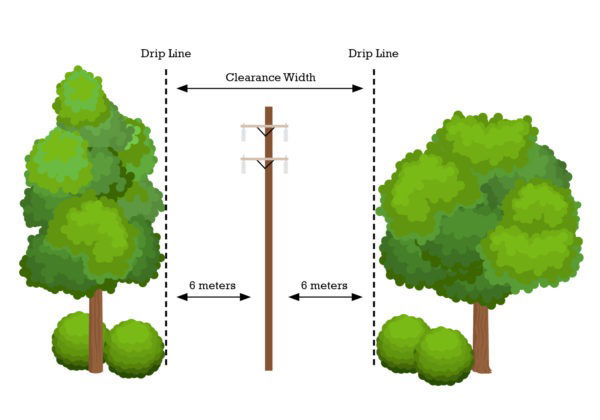Tree and Shrub Planting Guidelines
Members have a responsibility for vegetation management around the power distribution system on their respective property and their Electric Services Contract with Battle River Power Coop states that trees are not to be planted in the utility right of way.
What is a Utility Right of Way?
A utility right of way (ROW), also known as a utility corridor or power line corridor, is an area of land near a property line that allows access or transit permission to utility companies (including gas, water, cable, telephone, etc.) to perform routine maintenance or emergency repairs to their respective infrastructure. These ROW’s can contain underground cables and equipment as well as above-ground equipment such as transformers, power poles and overhead power lines. It is imperative that the area remain clear of debris and vegetation to accommodate routine and emergency servicing.
To accommodate clearance, it is important that members keep this in mind when landscaping. Through the careful selection and planting of shrubs and trees on their land and planting wisely, members can assist their Coop in controlling overall costs. Shelterbelts and landscape trees planted the required distance from the utility right of way corridor can grow to their full potential and better fulfill their intended functions without the need for costly tree/vegetation maintenance around poles and lines. A landscaper or greenhouse will be able to provide you mature tree heights and widths, so you can measure accordingly when planting.
Key considerations when landscaping your property are:
- Allow 6 meters of clearance from the 'drip line'’' (outer edge of mature vegetation) to any system of energized lines or structures. This means that when planting a tree make sure the trunk distance at planting will allow for the mature canopy to be 6 meters from a power line or pole. Depending on the tree size at maturity this means the trunk should be an additional 3 – 9 meters from the 6-meter mark. Please reference visual below.
- The same applies for shrubs and hedge vegetation which can be planted at the edge of the 6 meter line but you need to choose plant types that will not over grow and encroach on the right of way corridor when mature. Please reference visual below.

For secondary lines and member-owned equipment on their respective property they should practice safe distance planning as per the ROW guidelines. This will ensure that if any maintenance or repairs are required vegetation will not impede the work of the powerline technicians. Please note that Battle River Power Coop services secondary lines up to and including members’ power meters.
Please contact Battle River Power Coop (1-877-428-3972) to discuss options for managing vegetation growth. For guidelines on planting height and width distances and possible shrubs and trees to consider, view Utility Right of Way and Tree Planting.